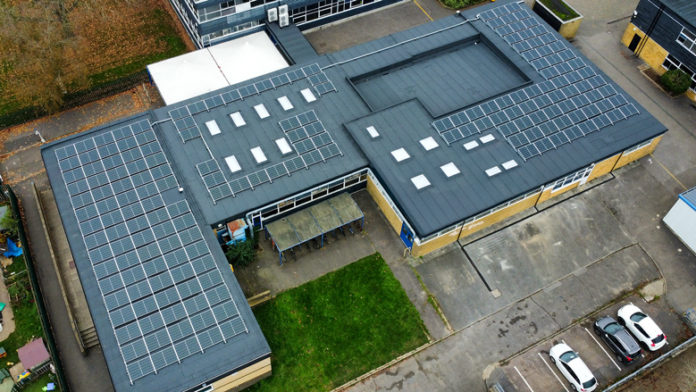Turning a Maintenance Problem into an Energy Opportunity
When the facilities team at Towers School in Kent discovered that one of their teaching blocks had a leaking flat roof, the immediate priority was to stop the water ingress and protect the building. But as they reviewed the condition of the roof, they saw a wider opportunity. The project could not only address the building’s maintenance needs but also contribute to the school’s long-term sustainability goals.
At a time when many schools face rising energy costs and mounting pressure to decarbonise their estates, Towers School’s approach reflects a broader shift towards more integrated, value-driven refurbishment.
The decision was made to take a joined-up approach, combining the roof refurbishment with a solar pv installation. The aim was to improve thermal performance, reduce carbon emissions, and stabilise energy costs through on-site generation. Working with building surveyors Carré Building Consultancy and technical experts from Garland UK, the school developed a single, integrated project that would deliver measurable performance improvements and financial returns.
A Coordinated Approach from Design to Delivery
From the outset, the focus was on coordination and accountability. Rather than treating the roof and solar works as separate contracts, the school wanted a single delivery partner who could design, oversee and guarantee both systems together. That decision shaped the entire project, removing the usual complexities that arise when multiple contractors are responsible for different aspects of the same roof.
Sam Rigden, Technical Manager at Garland UK, carried out detailed surveys and design work to specify a new waterproofing and insulation build-up using its StressPly Flex Plus bituminous membrane system. The solution was selected for its long service life, robust mechanical strength, and high thermal efficiency. The upgraded roof achieved a U-value of 0.18 W/m²K, significantly enhancing the building’s energy performance and reducing heat loss across the block. Once the new waterproofing was in place, a bespoke Solarise photovoltaic system was installed, designed and engineered to integrate seamlessly with the roof structure.

Measurable Reductions in Energy and Carbon
The outcome has been immediate and quantifiable. The solar array now generates over 40,000 kilowatt hours of clean electricity every year, offsetting a significant portion of the school’s grid consumption. The system is estimated to save over £13,000 in first-year energy costs and prevent over 17 tonnes of carbon dioxide emissions each year. The combined investment has delivered a payback period of just 4.5 years, meaning the system will continue to provide cost and carbon savings for decades after it has paid for itself.
For the school, these figures represent more than just operational savings. They are evidence that sustainability-led refurbishment can be financially viable within tight public-sector budgets when projects are properly integrated and technically assured. The improved roof insulation reduces heating demand throughout the winter months, while the solar generation cuts reliance on grid power, particularly during daytime teaching hours. Together, these improvements have delivered measurable reductions in both energy use and operational carbon, with minimal disruption to teaching activities.
Digital Oversight and Asset Management
A key factor in maintaining quality and performance throughout the project was Garland UK’s technical oversight. Site inspections were carried out twice weekly during the works, ensuring that every element of the design specification was met. All activity was recorded through Garland’s digital Roof Asset Management Programme, known as RAMP, which provides clients with live project data, photographs, and inspection records. This digital record now forms part of the school’s ongoing asset management system, helping the estate team plan future maintenance and monitor performance over time.
Removing Risk Through Single-Point Accountability
Perhaps the most distinctive feature of the Towers School project is the approach to warranty and risk. The school’s roof and solar systems are protected under Garland UK’s Single-Point Guarantee, which covers both design and installation across the full system. In practical terms, that means the school has one source of accountability for the performance of the entire installation. If an issue arises, whether with the waterproofing or the PV array, the estate team contacts Garland directly. There is no division of responsibility or dispute between manufacturers and contractors over which component is at fault. For estate managers managing large and complex property portfolios, this level of clarity can significantly reduce administrative burden and future risk exposure.
By capturing the full project history in one digital platform, the school’s estate team can now manage its roof assets more proactively, a model increasingly relevant to public-sector estate strategies.
A Model for Smarter Estate Investment
This project illustrates a growing shift in how energy and estate managers are approaching capital works. Rather than delivering single-issue repairs, many organisations are beginning to combine building fabric upgrades with renewable installations to maximise return on investment and reduce disruption. Integrated refurbishment provides an efficient route to net zero, improving energy performance, extending asset life and supporting financial resilience.
By aligning the refurbishment of existing assets with sustainability objectives, the school has achieved long-term energy and carbon savings, improved the resilience of its estate, and enhanced the learning environment for its students. It stands as a model for other schools and public-sector organisations facing the dual challenge of maintaining ageing infrastructure while advancing towards decarbonisation.
Building for the Long Term
For the education sector in particular, the lessons are clear. Sustainable refurbishment does not have to mean large-scale new builds or disruptive installations. By integrating roof, fabric, and renewable technologies within one coordinated design, estate managers can unlock efficiencies, extend the life of existing assets, and deliver measurable outcomes that support both operational and environmental goals.
Towers School’s project demonstrates the potential of integrating condition improvement and energy generation in a single programme, an approach that combines cost efficiency with measurable sustainability outcomes. It’s a reminder that sometimes the most powerful route to decarbonisation starts not with new technology, but with a smarter, joined-up way of thinking about the buildings we already have.
This article appeared in the Nov/Dec 2025 issue of Energy Manager magazine. Subscribe here.





